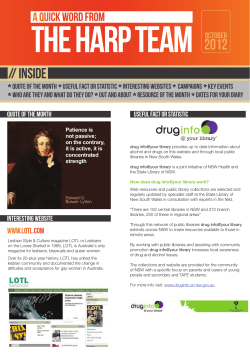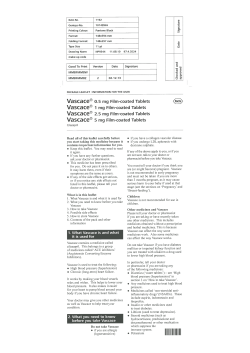
NDA 21035/S-089 & NDA 21505/S-030 Keppra tablet and oral solution
NDA 21035/S-089 & NDA 21505/S-030 Keppra tablet and oral solution FDA Approved Labeling text dated Jul 2013 MEDICATION GUIDE KEPPRA (KEPP-ruh) (levetiracetam) tablets and oral solution Read this Medication Guide before you start taking KEPPRA and each time you get a refill. There may be new information. This information does not take the place of talking to your healthcare provider about your medical condition or treatment. What is the most important information I should know about KEPPRA? Like other antiepileptic drugs, KEPPRA may cause suicidal thoughts or actions in a very small number of people, about 1 in 500 people taking it. Call a healthcare provider right away if you have any of these symptoms, especially if they are new, worse, or worry you: thoughts about suicide or dying attempts to commit suicide new or worse depression new or worse anxiety feeling agitated or restless panic attacks trouble sleeping (insomnia) new or worse irritability acting aggressive, being angry, or violent acting on dangerous impulses an extreme increase in activity and talking (mania) other unusual changes in behavior or mood Do not stop KEPPRA without first talking to a healthcare provider. Stopping KEPPRA suddenly can cause serious problems. Stopping a seizure medicine suddenly can cause seizures that will not stop (status epilepticus). Suicidal thoughts or actions can be caused by things other than medicines. If you have suicidal thoughts or actions, your healthcare provider may check for other causes. How can I watch for early symptoms of suicidal thoughts and actions? Reference ID: 3343504 Pay attention to any changes, especially sudden changes, in mood, behaviors, thoughts, or feelings. NDA 21035/S-089 & NDA 21505/S-030 Keppra tablet and oral solution FDA Approved Labeling text dated Jul 2013 Keep all follow-up visits with your healthcare provider as scheduled. Call your healthcare provider between visits as needed, especially if you are worried about symptoms. What is KEPPRA? KEPPRA is a prescription medicine taken by mouth that is used with other medicines to treat: partial onset seizures in people 1 month of age and older with epilepsy myoclonic seizures in people 12 years of age and older with juvenile myoclonic epilepsy primary generalized tonic-clonic seizures in people 6 years of age and older with certain types of generalized epilepsy. It is not known if KEPPRA is safe or effective in children under 1 month of age. Before taking your medicine, make sure you have received the correct medicine. Compare the name above with the name on your bottle and the appearance of your medicine with the description of KEPPRA provided below. Tell your pharmacist immediately if you think you have been given the wrong medicine. 250 mg KEPPRA tablets are blue, oblong-shaped, scored, film-coated tablets marked with “ucb 250” on one side. 500 mg KEPPRA tablets are yellow, oblong-shaped, scored, film-coated tablets marked with “ucb 500” on one side. 750 mg KEPPRA tablets are orange, oblong-shaped, scored, film-coated tablets marked with “ucb 750” on one side. 1000 mg KEPPRA tablets are white, oblong-shaped, scored, film-coated tablets marked with “ucb 1000” on one side. KEPPRA oral solution is a clear, colorless, grape-flavored liquid. What should I tell my healthcare provider before starting KEPPRA? Before taking KEPPRA, tell your healthcare provider about all of your medical conditions, including if you: have or have had depression, mood problems or suicidal thoughts or behavior have kidney problems are pregnant or planning to become pregnant. It is not known if KEPPRA will harm your unborn baby. You and your healthcare provider will have to decide if you should take KEPPRA while you are pregnant. If you become pregnant while taking KEPPRA, talk to your healthcare provider about registering with the North American Antiepileptic Drug Pregnancy Registry. You can enroll in this registry by calling 1-888-233-2334. You can also enroll in the UCB AED Pregnancy Registry by calling 1-888-537-7734. The purpose of these registries is to collect information about the safety of KEPPRA and other antiepileptic medicine during pregnancy. Reference ID: 3343504 NDA 21035/S-089 & NDA 21505/S-030 Keppra tablet and oral solution FDA Approved Labeling text dated Jul 2013 are breast feeding. KEPPRA can pass into your milk and may harm your baby. You and your healthcare provider should discuss whether you should take KEPPRA or breast-feed; you should not do both. Tell your healthcare provider about all the medicines you take, including prescription and nonprescription medicines, vitamins, and herbal supplements. Do not start a new medicine without first talking with your healthcare provider. Know the medicines you take. Keep a list of them to show your healthcare provider and pharmacist each time you get a new medicine. How should I take KEPPRA? Take KEPPRA exactly as prescribed. Your healthcare provider will tell you how much KEPPRA to take and when to take it. KEPPRA is usually taken twice a day. Take KEPPRA at the same times each day. Your healthcare provider may change your dose. Do not change your dose without talking to your healthcare provider. Take KEPPRA with or without food. Swallow the tablets whole. Do not chew or crush tablets. Ask your healthcare provider for KEPPRA oral solution if you cannot swallow tablets. If your healthcare provider has prescribed KEPPRA oral solution, be sure to ask your pharmacist for a medicine dropper or medicine cup to help you measure the correct amount of KEPPRA oral solution. Do not use a household teaspoon. Ask your pharmacist for instructions on how to use the measuring device the right way. If you miss a dose of KEPPRA, take it as soon as you remember. If it is almost time for your next dose, just skip the missed dose. Take the next dose at your regular time. Do not take two doses at the same time. If you take too much KEPPRA, call your local Poison Control Center or go to the nearest emergency room right away. What should I avoid while taking KEPPRA? Do not drive, operate machinery or do other dangerous activities until you know how KEPPRA affects you. KEPPRA may make you dizzy or sleepy. What are the possible side effects of KEPPRA? See “What is the most important information I should know about KEPPRA?” KEPPRA can cause serious side effects. Call your healthcare provider right away if you have any of these symptoms: mood and behavior changes such as aggression, agitation, anger, anxiety, apathy, mood swings, depression, hostility, and irritability. A few people may get psychotic symptoms Reference ID: 3343504 NDA 21035/S-089 & NDA 21505/S-030 Keppra tablet and oral solution FDA Approved Labeling text dated Jul 2013 such as hallucinations (seeing or hearing things that are really not there), delusions (false or strange thoughts or beliefs) and unusual behavior. extreme sleepiness, tiredness, and weakness problems with muscle coordination (problems walking and moving) a skin rash. Serious skin rashes can happen after you start taking KEPPRA. There is no way to tell if a mild rash will become a serious reaction. The most common side effects seen in people who take KEPPRA include: sleepiness weakness infection dizziness The most common side effects seen in children who take KEPPRA include, in addition to those listed above: tiredness acting aggressive nasal congestion decreased appetite irritability These side effects can happen at any time but happen more often within the first 4 weeks of treatment except for infection. Tell your healthcare provider if you have any side effect that bothers you or that does not go away. These are not all the possible side effects of KEPPRA. For more information, ask your healthcare provider or pharmacist. Call your doctor for medical advice about side effects. You may report side effects to FDA at 1-800-FDA-1088. How should I store KEPPRA? Store KEPPRA at room temperature, 59F to 86F (15C to 30C) away from heat and light. Keep KEPPRA and all medicines out of the reach of children. General information about KEPPRA. Medicines are sometimes prescribed for purposes other than those listed in a Medication Guide. Do not use KEPPRA for a condition for which it was not prescribed. Do not give KEPPRA to other people, even if they have the same symptoms that you have. It may harm them. Reference ID: 3343504 NDA 21035/S-089 & NDA 21505/S-030 Keppra tablet and oral solution FDA Approved Labeling text dated Jul 2013 This Medication Guide summarizes the most important information about KEPPRA. If you would like more information, talk with your healthcare provider. You can ask your pharmacist or healthcare provider for information about KEPPRA that is written for health professionals. You can also get information about KEPPRA at www.keppra.com or call 1 866-822-0068. What are the ingredients of KEPPRA? KEPPRA tablet active ingredient: levetiracetam Inactive ingredients: colloidal silicon dioxide, croscarmellose sodium, magnesium stearate, polyethylene glycol 3350, polyethylene glycol 6000, polyvinyl alcohol, talc, titanium dioxide, and additional agents listed below: 250 mg tablets: FD&C Blue #2/indigo carmine aluminum lake 500 mg tablets: iron oxide yellow 750 mg tablets: FD&C yellow #6/sunset yellow FCF aluminum lake, iron oxide red KEPPRA oral solution active ingredient: levetiracetam Inactive ingredients: ammonium glycyrrhizinate, citric acid monohydrate, glycerin, maltitol solution, methylparaben, potassium acesulfame, propylparaben, purified water, sodium citrate dihydrate and natural and artificial flavor. KEPPRA does not contain lactose or gluten. KEPPRA oral solution does contain carbohydrates. The liquid is dye-free. This Medication Guide has been approved by the US Food and Drug Administration. Distributed by UCB, Inc. Smyrna, GA 30080 KEPPRA is a registered trademark of the UCB Group of companies © 2011, UCB, Inc., Smyrna, GA 30080 All rights reserved. Printed in the U.S.A. Rev. 12/2011 Reference ID: 3343504
© Copyright 2025











